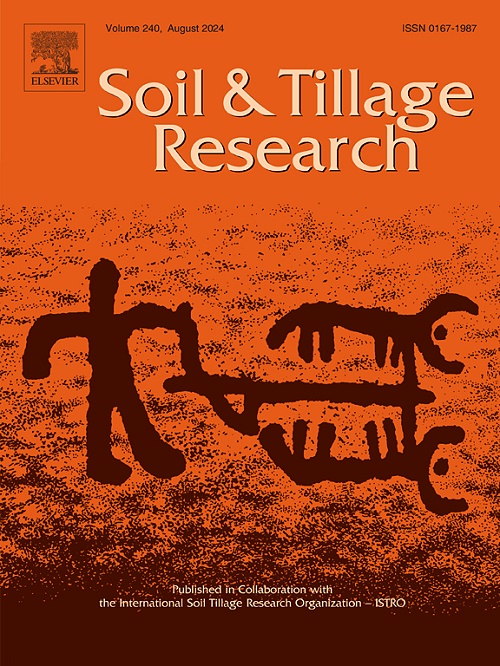Use of Vis-NIR reflectance spectroscopy for estimating soil phosphorus sorption parameters at the watershed scale
IF 6.1
1区 农林科学
Q1 SOIL SCIENCE
引用次数: 0
Abstract
Measurement of soil phosphorus sorption parameters (PSPs) provides crucial information on P fertilization and P leaching. Traditional approaches for determining these indices are expensive and time-consuming. To develop rapid indirect methods, this study aims to assess the effectiveness of Vis-NIR spectroscopy ranging from 350 to 2500 nm for estimating various PSPs, including maximum buffering capacity (MBC), the standard buffering capacity (SBC), P sorption maximum (Qmax), soil P buffering capacity (PBC), and standard P requirement (SPR). We collected 100 soil samples in western Iran and related Vis-NIR data to the PSP parameters via Partial least squares regression (PLSR) and artificial neural network (ANN). The observed PSP values showed large variabilities across sites (CV> 48 %), attributed primarily to the wide variation in soil properties controlling PSPs. The PLSR model highlighted that efficient spectral peaks in the band-wise regression coefficients were strongly associated with signature wavelengths of clay minerals, soil organic carbon, and cation exchange capacity, all are key factors influencing the PSP indices. However, the PLSR models had limited predictive power for the PSPs, due to the complex relationships between spectral data and various soil properties indirectly influencing PSPs. Compared to PLSR, the nonlinear ANN model enhanced the prediction accuracy of MBC, PBC, Qmax, SBC, and SPR by 39.25 %, 50 %, 19.28 %, 39.41 %, and 59.32 %, respectively. The best coefficient of determination achieved in validation dataset by the ANN model ranged from 0.65 to 0.85, which is deemed acceptable for practical use on large scale by local farmers and decision-makers for P fertilization strategies.
利用可见光-近红外反射光谱估算流域尺度的土壤磷吸附参数
土壤磷吸附参数(PSPs)的测定为磷施肥和磷淋溶提供了重要信息。确定这些指数的传统方法既昂贵又耗时。为了建立快速的间接方法,本研究旨在评估350 ~ 2500 nm范围内的Vis-NIR光谱对各种psp的有效性,包括最大缓冲容量(MBC)、标准缓冲容量(SBC)、最大磷吸收(Qmax)、土壤磷缓冲容量(PBC)和标准磷需要量(SPR)。利用偏最小二乘回归(PLSR)和人工神经网络(ANN)将伊朗西部100个土壤样品的Vis-NIR数据与PSP参数相关联。观测到的PSP值在不同站点间存在较大差异(CV>;48 %),主要归因于控制PSPs的土壤性质的广泛差异。PLSR模型表明,有效光谱峰与黏土矿物特征波长、土壤有机碳和阳离子交换容量密切相关,是影响PSP指数的关键因素。然而,由于光谱数据与各种土壤性质之间的复杂关系间接影响了土壤土壤质量,PLSR模型对土壤土壤质量的预测能力有限。与PLSR相比,非线性神经网络模型对MBC、PBC、Qmax、SBC和SPR的预测精度分别提高了39.25 %、50 %、19.28 %、39.41 %和59.32 %。人工神经网络模型在验证数据集中获得的最佳决定系数范围为0.65 ~ 0.85,这被当地农民和决策者认为可以接受大规模的磷肥施肥策略。
本文章由计算机程序翻译,如有差异,请以英文原文为准。
求助全文
约1分钟内获得全文
求助全文
来源期刊

Soil & Tillage Research
农林科学-土壤科学
CiteScore
13.00
自引率
6.20%
发文量
266
审稿时长
5 months
期刊介绍:
Soil & Tillage Research examines the physical, chemical and biological changes in the soil caused by tillage and field traffic. Manuscripts will be considered on aspects of soil science, physics, technology, mechanization and applied engineering for a sustainable balance among productivity, environmental quality and profitability. The following are examples of suitable topics within the scope of the journal of Soil and Tillage Research:
The agricultural and biosystems engineering associated with tillage (including no-tillage, reduced-tillage and direct drilling), irrigation and drainage, crops and crop rotations, fertilization, rehabilitation of mine spoils and processes used to modify soils. Soil change effects on establishment and yield of crops, growth of plants and roots, structure and erosion of soil, cycling of carbon and nutrients, greenhouse gas emissions, leaching, runoff and other processes that affect environmental quality. Characterization or modeling of tillage and field traffic responses, soil, climate, or topographic effects, soil deformation processes, tillage tools, traction devices, energy requirements, economics, surface and subsurface water quality effects, tillage effects on weed, pest and disease control, and their interactions.
 求助内容:
求助内容: 应助结果提醒方式:
应助结果提醒方式:


